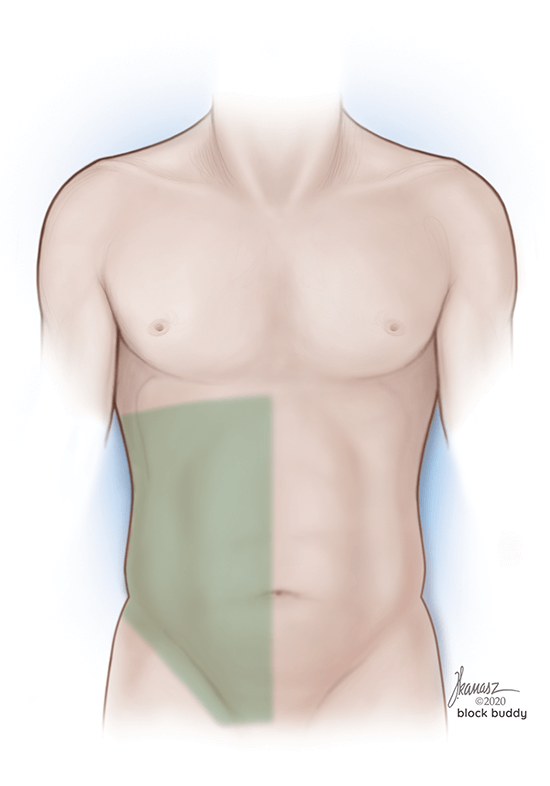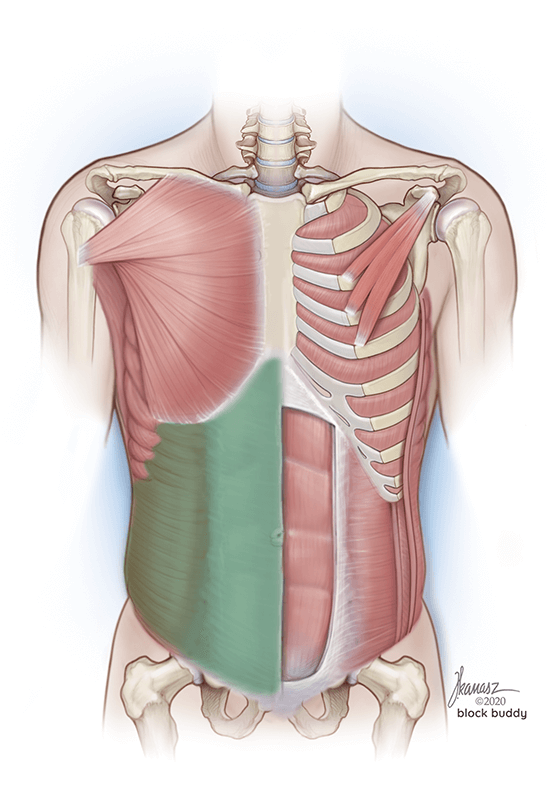Quadratus Lumborum Block (QL3)


The quadratus lumborum (QL3) block, also known as a transmuscular or anterior QL block, is a fascial plane block that is performed anterior to the quadratus lumborum. The proposed mechanism of action involves the spread of local anesthetic into the thoracic paravertebral space to target the dorsal rami, ventral rami, and sympathetic trunk. As a result, the QL3 block may provide somatic and visceral analgesia of the abdomen. Additionally, the QL3 approach may also block mechanoreceptors and nociceptors located within the thoracolumbar fascia. Indications for performing a QL3 block includes:
- Upper and lower abdominal surgery
- Inguinal hernia
- Retroperitoneal surgery
- Cesarean section
- Chronic abdominal neuropathic pain
- Iliac crest bone graft
- Hip arthroplasty
Overview of the Quadratus Lumborum (QL3) Block
Distribution of the QL3 block is variable, but may provide analgesia from T7-L1 or T10-L1. Studies show that the quadratus lumborum block reduces opioid consumption after a cesarean for 48 hours. Moreover, patients who receive the quadratus lumborum block as part of post-operative pain management have lower pain levels when resting and moving–an important factor in early mobilization.
Risks and Side Effects
All procedures that utilize anesthesia have their own set of risks. Some risks and complications involving a QL3 block may include:
- Allergic reaction
- Hematoma
- Infection
- Local anesthetic systemic toxicity (LAST)
- Lower-limb weakness
How to Perform the Quadratus Lumborum (QL3) Block
The block should be performed bilaterally if the surgical procedure is laparoscopic, involves both sides of the abdomen, or includes a midline incision. The block should be performed unilaterally if the surgical procedure only involves one side of the abdomen. The patient should be placed in a lateral position. The transducer is placed in a transverse position between the costal margin and the iliac crest along the mid-axillary line. Initially, the 3 muscle layers of the lateral abdominal wall are identified. The transducer is then slid posteriorly to identify the muscles of the posterior abdominal wall: quadratus lumborum, psoas major, and erector spinae. Insert the needle 2 to 3 cm posterior to the transducer and advance in-plane using a posterior to anterior direction until the needle tip lies within the anterior thoracolumbar fascia between the psoas major and quadratus lumborum muscles. Inject 3-5 incremental doses of a local anesthetic to a total of 30-40ml per side. For a more thorough review of this block and the QL2 block, use the Block Buddy Pro app.
Get Complete Instructions in the Block Buddy Pro App
Block Buddy Pro is an excellent resource to support anesthesia providers in administering ultrasound-guided nerve blocks. The Quadratus Lumborum Block Lesson in the Block Buddy Pro app includes:
- Easily accessible instructions
- Anatomy breakdown including the abdominal wall, fascia, and muscles
- 18 images consisting of detailed illustrations, ultrasound images, and photos from inside the operating room.
- A guided video with step-by-step instructions.
- Clinical pearls to make it easier to identify the QL muscle
You will also gain access to 33 detailed block lessons. The app features an interactive notes section, and is also usable offline! Block Buddy Pro is available on all devices (mobile, tablet, and desktop) and can be purchased in the App Store and Google Play Store. To get started, simply create your account now!
